Sound Summary Class 9 Science Chapter 11
Introduction
- The sensation felt by our ears is called sound.
- Sound is a form of energy which makes us hear.
- Law of conservation of energy is also applicable to sound.
- Sound travels in form of wave.
Production of Sound
- Sound is produced when object vibrates or sound is produced by vibrating objects.
- The energy required to make an object vibrate and produce sound is provided by some outside source (like our hand, wind etc.).
Example:- Sound of our voice is produced by vibration of two vocal cords in our throat.
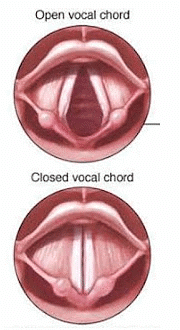
- Sound of a drum or tabla is produced by vibration of its membrane when struck.
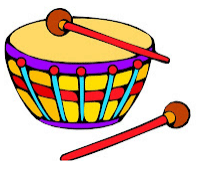
- Sound of our voice is produced by vibration of two vocal cords in our throat.
- In laboratory experiments, sound is produced by vibrating tuning fork. The vibrations of tuning fork can be shown by touching a small suspended pith ball (cork ball) with a prong of the sounding tuning fork. The pith ball is pushed away with a great force.
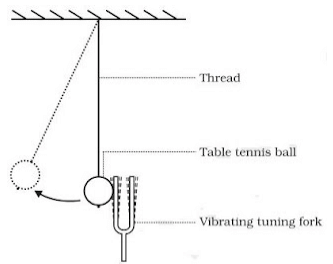
Sound can be produced by following methods:
- By vibrating string (sitar)
- By vibrating air (flute)
- By vibrating membrane (table, drum)
- By vibrating plates (bicycle bell)
- By friction in objects
- By scratching or scrubbing the objects etc.
Propogation of Sound
- The substance through which sound travels is called a medium.
- The medium may be solid, liquid or gas.
- When an object vibrates, then the air particles around it also start vibrating in exactly the same way and displaced from their stable position.
- These vibrating air particles exert a force on nearby air particles so they are also displaced from their rest position and start to vibrate.
- This process is continued in the medium till sound reaches our ears.
- The disturbance produced by sound travels through the medium (not the particles of the medium).
- Wave is a disturbance which travels through a medium and carries energy.
- So sound travels in wave form known as mechanical waves.

- When a body vibrates then it compresses the air surrounding it and form a area of high density called compression (C).
- Compression is the part of wave in which particles of the medium are closer to one another forming high pressure.
- This compression move away from the vibrating body.
- When vibrating body vibrates back a area of low pressure is formed called rarefaction (R).
- Rarefaction is the area of wave in which particles of the medium are further apart from one another forming a low pressure or low density area.
- When body vibrates back and forth, a series of compression and rarefaction is formed in air resulting in sound wave.
- Propogation of sound wave is propogation of density change.
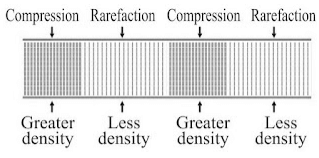
Sound needs Medium for Propogation
- Sound waves are mechanical waves.
- It needs material medium for propogation like air, water, steel etc.
- It cannot travel in vaccum.
- An electric bell is suspended in airtight bell jar connected with vacuum pump.
- When bell jar is full of air, we hear the sound but when air is pumped out from the bell jar by vacuum pump and we ring the bell, no sound is heard.
- So, medium is necessary for propagation of sound.
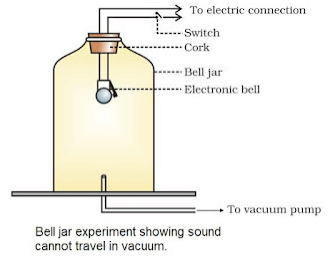
Experiment to show that sound cannot travel through vacuum
Sound Waves as Longitudinal Waves
- A wave in which the particles of the medium vibrate back and forth in the same direction in which the wave is moving, is called a longitudinal wave.
- When we push and pull the slinky compression (number of turns are more or closer) and rarefaction (number of turns are less or farther) are formed.
- When a wave travels along with slinky, its each turn moves back and forth by only a small distance in the direction of wave. So the wave is longitudinal.
- The direction of vibrations of the particles is parallel to the direction of wave.

- When one end of a slinky is moved up and down rapidly whose other end is fixed, it produces transverse wave.
- This wave possess along the slinky in horizontal direction, while turns of slinky (particles) vibrate up and down at right angle to the direction of wave.
- Thus in transverse wave particles of the medium vibrate up and down at right angles to the direction of wave.
- Light waves are transverse waves but they don’t need a material medium for propagation.

Characteristics of Sound Wave
- The characteristics of sound waves are : wavelength, frequency, amplitude, time period and velocity.
- When a wave travel in air the density and pressure of air changes from their mean position.
- Compression is shown by crest while rarefaction is shown by trough.
- Compression is the region of maximum density or pressure.
- Rarefaction is the region of minimum density or pressure.

Wavelength
- In sound waves the combined length of a compression and an adjacent rarefaction is called its wavelength.
- The distance between the centres of two consecutive compressions or two consecutive rarefactions is also called its wavelength.
- It is denoted by the Greek letter lamda (λ). Its SI unit is metre.
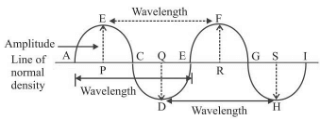
Frequency
- No. of complete waves produced in one second or number of vibrations per second is called frequency.
- Number of compressions or rarefactions passed in one second is also frequency.
- Frequency of wave is same as the frequency of the vibrating body which produces the wave.
- The SI unit of frequency is hertz (Hz). The symbol of frequency is v (nu).
- 1 Hertz: One Hz is equal to 1 vibration per second.
- Bigger unit of frequency is kilohertz kHz = 1000 Hz.
Time Period
- Time taken to complete one vibration is called time period.
- Time required to pass two consecutive compressions or rarefactions through a point is called time period.
- SI unit of time period is second (s). Time period is denoted by T.
- The frequency of a wave is the reciprocal of the time period.
- v = 1/T
Amplitude
The maximum displacement of the particle of the medium from their original undisturbed position is called amplitude of the wave.
- Amplitude is denoted by A and its SI unit is metre (m).
- Sound have characteristics like pitch and loudness and timbre.
- Pitch: The pitch of sound depends on the frequency of sound (vibration).
- It is directly proportional to its frequency. Greater the frequency, higher is the pitch and lesser the frequency, lower is the pitch.
- A woman’s voice is shrill having a high pitch while a man’s voice is flat having low pitch.
- High pitch sound has large number of compressions and rarefactions passing a fixed point per unit time.

- Loudness: The loudness depends on the amplitude of the sound wave.
- Loudness is the measure of the sound energy reaching the ear per sec.
- Greater the amplitude of sound wave, greater is the energy, louder the sound; short is the amplitude, less is the energy, soft is the sound.
- Loudness is measured in decibel ‘dB’.

- Quality or Timbre: The timbre of a sound depends on the shape of sound wave produced by it. It is the characteristic of musical sound.
- It helps us to distinguish between two sounds of same pitch & loudness.
- Sound of single (same) frequency is called tone while a mixture of different frequencies is called note.
- Noise is unpleasant to hear while music is pleasant to hear and it is of good quality.
Velocity
- The distance travelled by a wave in one second is called velocity of the wave.
- Its SI unit is metre per second (ms-1).
Velocity = Distance travelled/Time taken
⇒ v = λ/T
(λ is the wavelength of the waves travelled in one time time period T)
v = λv (1/T = v)
So, Velocity = Wavelength × Frequency
This is the wave equation.
Example: What is the frequency of sound wave whose time period is 0.05 second ?
Frequency, v = 1/T
Given T = 0.05 s
v = 1/0.005 = 100/5 = 20Hz
∴ Frequency = 20 Hz.
Speed of Sound in Various Mediums
- Speed of sound depends on the nature of material through which it travels. It is slowest in gases, faster in liquids and fastest in solids.
- Speed of sound increases with the rise in temperature.
- Speed of sound increases as humidity of air increases.
- Speed of light is faster than speed of sound.
- In air, speed of sound is 344 ms-1 at 22ºC.
Sonic Boom
- Some aircrafts, bullets, rockets etc. have ‘supersonic speed’.
- Supersonic refers to the speed of an object which is greater than the speed of sound and it produces extremely loud sound waves called ‘shock waves’ in air.
- Sonic boom is an explosive noise caused by shock waves.
- It emits tremendous sound energy which can shatter the glass panes of windows.
Reflection of Sound
- Like light, sound also bounce back when it falls on a hard surface. It is called reflection of sound.
- The laws of reflection of light are obeyed during reflection of sound.
(i) The incident sound wave, the reflected sound wave and normal at the point of incidence lie in the same plane.
(ii) Angle of reflection of sound is always equal to the angle of incidence of sound.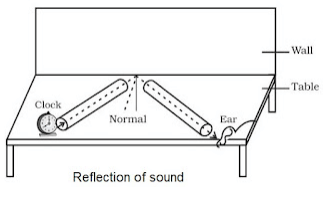
- The laws of reflection of light are obeyed during reflection of sound.
Echo
- The repetition of sound caused by the reflection of sound waves is called an echo.
- We can hear echo when there is a time gap of 0.1 second in original sound and echo (reflected sound).
- Echo is produced when sound reflected from a hard surface (i.e. brick wall, mountain etc.) as soft surface tends to absorb sound.
Minimum distance to hear an echo
Speed = Distance/Time
Here, Speed of sound in air = 344 ms-1 at 22ºC
Time = 0.1 second
344 = Distance/0.1 sec
⇒ Distance = 344 × 0.1 = 34.4 m
So, distance between reflecting surface and audience = 34.4/2 = 17.2 (at 22ºC).
- Rolling of thunder is due to multiple reflection of sound of thunder from a number of reflecting surfaces such as clouds and the earth.
Reverberation
- The persistence of sound in a big hall due to repeated reflection of sound from the walls, ceiling and floor of the hall is called reverberation.
- If reverberation is too long, sound becomes blurred, distorted and confusing due to overlapping of different sound.
Methods to reduce reverberation in big halls or auditoriums
- Panels made of felt or compressed fibre board are put on walls and ceiling to absorb sound.
- Heavy curtains are put on doors and windows.
- Carpets are put on the floor.
- Seats are made of material having sound absorbing properties.
Applications of Reflection of Sound
- Megaphone, loudspeakers, bulb horns and trumpets, shehnai etc. are designed to send sound in a particular direction without spreading all around.
- All these instruments have funnel tube which reflects sound waves repeatedly towards audience. In this amplitude of sound waves adds up to increase loudness of sound.
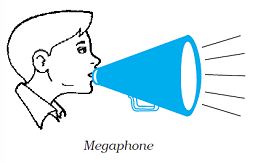

- All these instruments have funnel tube which reflects sound waves repeatedly towards audience. In this amplitude of sound waves adds up to increase loudness of sound.
- Stethoscope: It is a medical instrument used for listening the sounds produced in human body mainly in heart and lungs. The sound of the heartbeats reaches the doctor’s ears by the multiple reflection of the sound waves in the rubber tube of stethoscope.

- Sound Board: In big halls or auditoriums sound is absorbed by walls, ceiling, seats etc. So a curved board (sound board) is placed behind the speakers so that his speech can be heard easily by audiences. The soundboard works on the multiple reflection of sound.
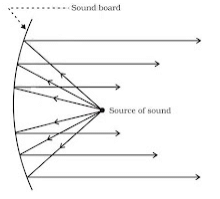
- The ceiling of concert halls are made curved, so that sound after reflection from ceiling, reaches all the parts of the hall.
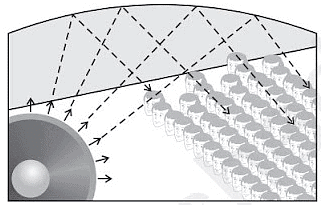
Range of Hearing
- Range of hearing in human is 20 Hz to 20000 Hz.
- Children younger than 5 years and dogs can hear upto 25 KHz.
- The sounds of frequencies lower than 20 Hz are known as ‘infrasonic sounds’.
- A vibrating simple pendulum produces infrasonic sounds.
- Rhinoceroses communicate each other using frequencies as low as 5 Hz.
- Elephants and whales produces infrasonic waves.
- Earthquakes produces infrasonic waves (before shock waves)
which some animals can hear and get disturbed.
- The sounds of frequencies higher than 20 KHz are known as ‘ultrasonic waves’.
- Dogs, parpoises, dolphins, bats and rats can hear ultrasonic sounds.
- Bats and rats can produce ultrasonic sounds.
Hearing Aid
- It is battery operated electronic device used by persons who are hard of hearing.
- Microphone convert sound into electrical signals, than those are amplified by amplifier. Amplified signals are send to the speaker of hearing aid. The speaker converts the amplified signal to sound and sends to ear for clear hearing.
Applications of Ultrasound
- It is used to detect cracks in metal blocks in industries without damaging them.
- It is used in industries to clean ‘hard to reach’ parts of objects such as spiral tubes, odd shaped machines etc.
- It is used to investigate the internal organs of human body such as liver, gall bladder, kidneys, uterus and heart.
- Ecocardiography: These waves are used to reflect the action of heart and its images are formed. This technique is called echocardiography.
- Ultrasonography: The technique of obtaining pictures of internal organs of the body by using echoes of ultrasound waves is called ultrasonography.
- Ultrasound is used to split tiny stones in kidneys into fine grains.
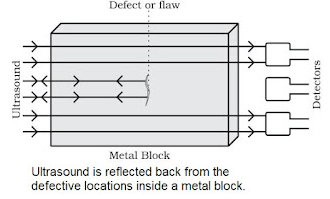
SONAR
- The word ‘SONAR’ stands for ‘Sound Navigation And Ranging’.
- SONAR is a device which is used to find distance, direction and speed of underwater objects.
- SONAR consists of a transmitter and a receptor or detector and installed at the bottom of a ship.
- The transmitter produces and transmits ultrasonic waves.
- These waves travel through water and after striking the objects on the bottom of sea, are reflected back and received by detector.
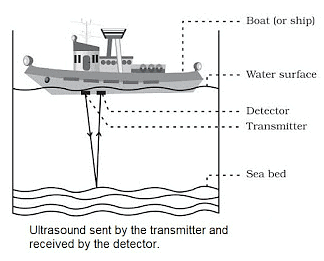
- These reflected waves are converted into electric signals by detector.
- The sonar device measures the time taken by ultrasound waves to travel from ship to bottom of sea and back to ship.
- Half of this time gives the time taken by the ultrasound waves from ship to bottom.
- Let the time interval between transmission and reception of ultrasound signal is t.
Speed of sound through sea water is v
Total distance travelled by waves = 2d.
Then, 2d = v × t.
This is called echo ranging.
- Let the time interval between transmission and reception of ultrasound signal is t.
- The sonar is used to find the depth of sea, to locate underwater hills, valleys, submarines, icebergs and sunken ships etc.
- Bats fly in the dark night by emitting high pitched ultrasound waves which are reflected from the obstacle or prey and returned to bats ear.
- The nature of reflection tells the bat where the obstacle or prey is and what it is like.
Structure of Human Ear
- The ear consists of three parts: outer ear, middle ear and inner ear.
- The ears are the sense organs which help us in hearing sound.
- The outer ear is called pinna. It collects the sound from surroundings.
- This sound passes through the auditory canal.
- At the end of auditory canal, is a thin elastic membrane called ear drum or tympanic membrane.
- The middle ear contains of three bones: hammer, anvil and stirrup linked with one another. Free end of hammer touches ear drum and that of stirrup linked with membrane of oval window of inner ear.
- The lower part of middle ear has a narrow ‘Eustachian tube’.
- The inner ear has a coiled tube called cochlea, which is connected with oval window. Cochlea is filled with a liquid containing nerve cells.
- Other side of cochlea is connected to auditory nerve which goes to brain.
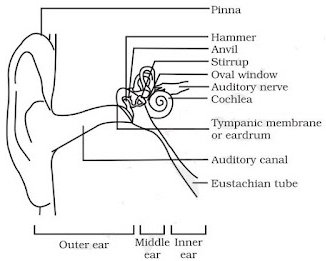
Working of Human ear
Pinna → Ear canal → Ear drum → Hammer → Anvil → Stirrup → Oval window → Cochlea → Auditory nerve → Brain
- When compression of sound wave strikes the ear drum, the pressure on the outside of ear drum increases and pushes the ear drum inwards.
- While during rarefaction ear drum moves outwards. Thus, ear drum starts vibrating back and forth.
- These vibrations are increased by three bones and middle ear transmits these amplified pressure variations received from sound waves to inner ear.
- In the inner ear the pressure variations are turned into electric signals by the cochlea.
- These electric signals are sent to the brain via auditory nerve and the brain interprets them as sound.
|
31 videos|126 docs|52 tests
|
FAQs on Sound Summary Class 9 Science Chapter 11
| 1. What is sound? |  |
| 2. How does sound travel? |  |
| 3. What is the speed of sound? |  |
| 4. How do we hear sound? |  |
| 5. What factors affect the loudness and pitch of sound? |  |





















